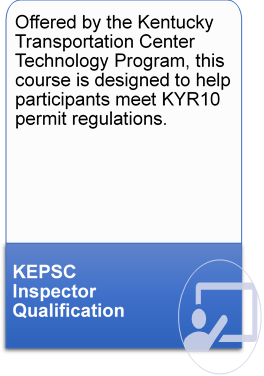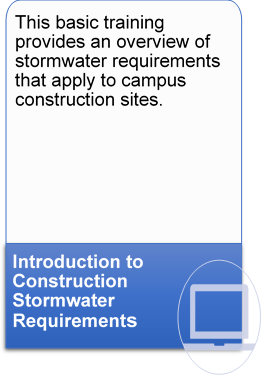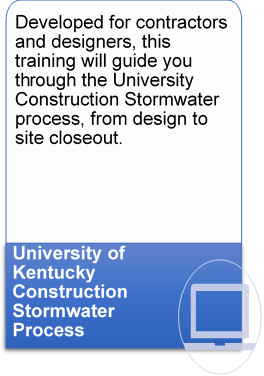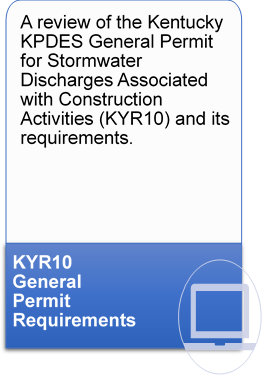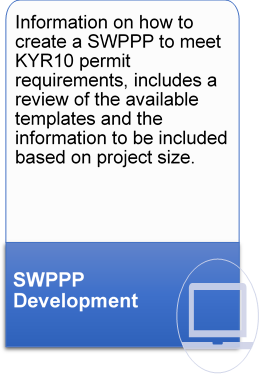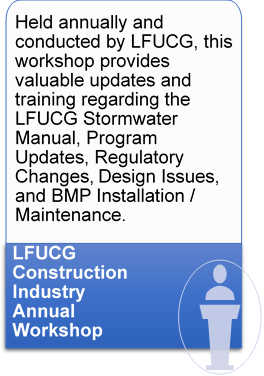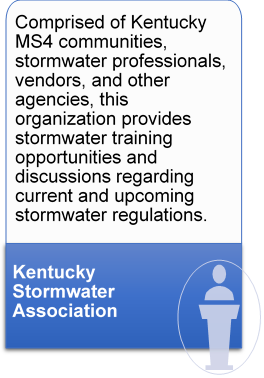Construction
Introduction
 The University’s MS4 Permit requires a Construction Site Stormwater Runoff Control Program to be developed, implemented, and enforced in order to reduce the impact of construction site runoff on the waters of the Commonwealth. To reduce this impact, BMPs, both structural and non-structural, must be utilized to prevent any soil, liquid, or debris from leaving a construction site and entering the storm sewer system.
The University’s MS4 Permit requires a Construction Site Stormwater Runoff Control Program to be developed, implemented, and enforced in order to reduce the impact of construction site runoff on the waters of the Commonwealth. To reduce this impact, BMPs, both structural and non-structural, must be utilized to prevent any soil, liquid, or debris from leaving a construction site and entering the storm sewer system.
Post-Construction BMPs are also required to be incorporated into design plans in order to provide stormwater quantity and quality treatment over the life of a property’s use. This section discusses construction and post-construction requirements since both are to be addressed during the project design process. To learn more about existing post-construction BMP’s on campus, see our Post-Construction BMP section.
Requirements
Review/Approval
In order to meet permit requirements, all construction within the MS4 boundary (the contiguous main campus) must have Best Management Practices (BMPs) designed and in place on all projects. Staff from the University’s Capital Projects Management Division (CPMD) and Environmental Quality Management Department (EQMD) review and approve plans regarding construction site stormwater for all projects, regardless of size. As a result, a LFUCG Land Disturbance Permit is not required. If/when plans are approved, the University will issue an approval to proceed via email rather than a formal permit.
Project stormwater requirements are outlined in the General Conditions of the Contract for Construction by a General Contractor, University Official Design Standards: 334000S01 Storm Drainage Utilities, adopted LFUCG standards, and Kentucky Division of Water (KDOW) stormwater regulations. Specific responsibilities are placed on the Architect/Engineering professional and also on the Construction Manager/Contractor in charge of each project. Details of these responsibilities can be found in the University Official Design Standards. Likewise, the University of Kentucky Campus Landscape Guidelines are available to provide guidance with regard to green infrastructure and low impact development and should be referenced during the design process.
The following information is to be provided for projects based on their size and activity as part of Phase 2 design documents. Submittals should be provided to the CPMD Water Quality Manager, CPMD Project Manager, and the EQMD Water Quality Compliance Manager:
|
Submittal Requirements |
|||||||
|---|---|---|---|---|---|---|---|
|
Activity/Project Size |
Document |
||||||
|
Design Drawings |
Project Narrative |
Executive Summary |
|||||
|
Construction with Limits of Disturbance ≥ 1 acre |
• |
• |
• |
• |
• |
• |
• |
|
Limits of Disturbance < 1acre, but part of a larger common plan |
• |
• |
• |
• |
• |
• |
• |
|
Limits of Disturbance > 5000 square feet and < 1 acre |
• |
|
• |
• |
• |
|
|
|
Limits of Disturbance < 5000 square feet^ |
|
|
• |
• |
• |
|
|
|
Linear Utility Line Projects that disturb ≥ 500 linear feet of unpaved land surface, but < 1 acre |
• |
|
• |
• |
|
|
|
|
Linear Utility Line Projects that disturb ≥ 1 acre |
• |
• |
• |
• |
|
• |
• |
|
Linear Utility Line Projects that disturb ≥ 500 linear feet or more of paved land surface and place all excavated materials into truck or other transportable soil containment device |
|
|
• |
• |
|
|
|
|
*Limits of Disturbance include equipment & material storage/laydown area **A 50-foot buffer must be maintained along streams, wetlands, sinkholes, or stormwater inlets. If a 50-foot buffer isn’t feasible, then an alternate BMP must be used. ^ BMPs must be used to minimize soil erosion and offsite sediment loss.
|
|||||||
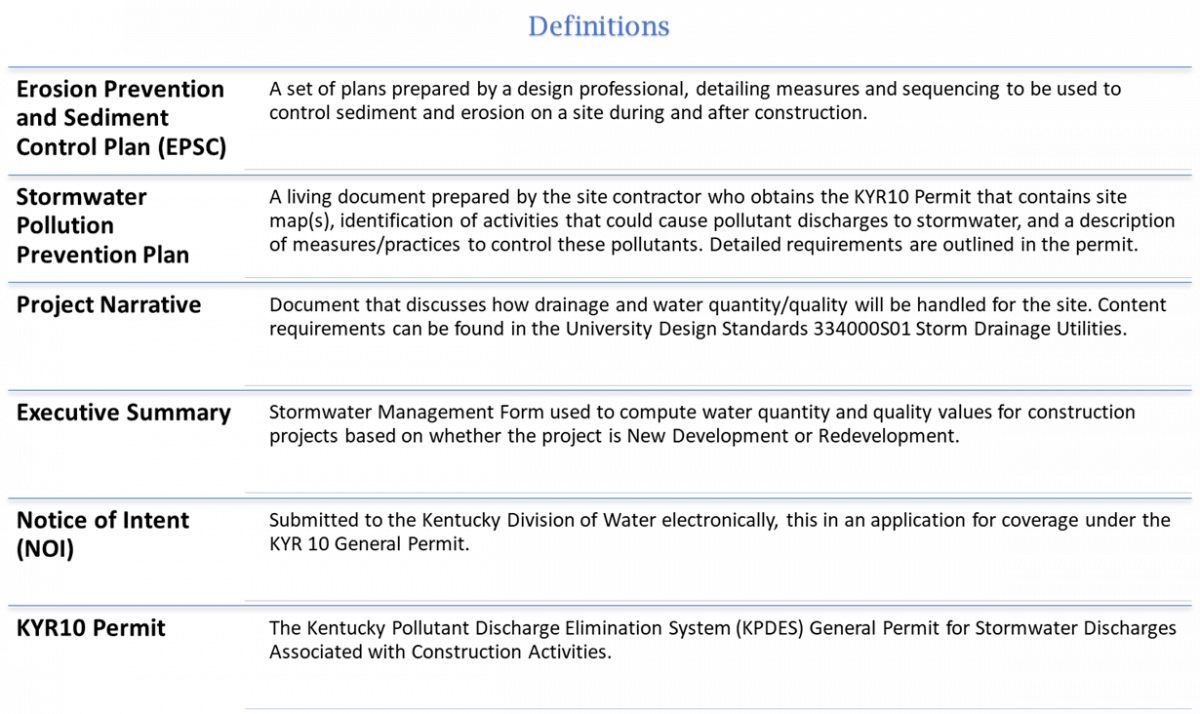
After project is awarded, a mandatory pre-construction meeting will be held with CPMD staff and contractors to review stormwater requirements and expectations before work begins. The EPSC will be discussed to ensure that all parties understand the requirements. The contractor will also need to identify the initial measures to be installed prior to the beginning of land disturbance activities. Any EPSC modifications due to constructability issues should be discussed at this time. The NOI must be filed with the KDOW, permit coverage obtained, the SWPPP submitted and approved, and all required BMPs installed in accordance with the EPSC Plan and SWPPP before land disturbing activities can begin.
Click image to open full version
Construction
The following is a summary of requirements that the contractor must meet during construction. These items are specified in the General Condition of the Contract for Construction. Please see this document in its entirety for more details. All operators working on the project are required to comply with the EPSC Plan and SWPPP.
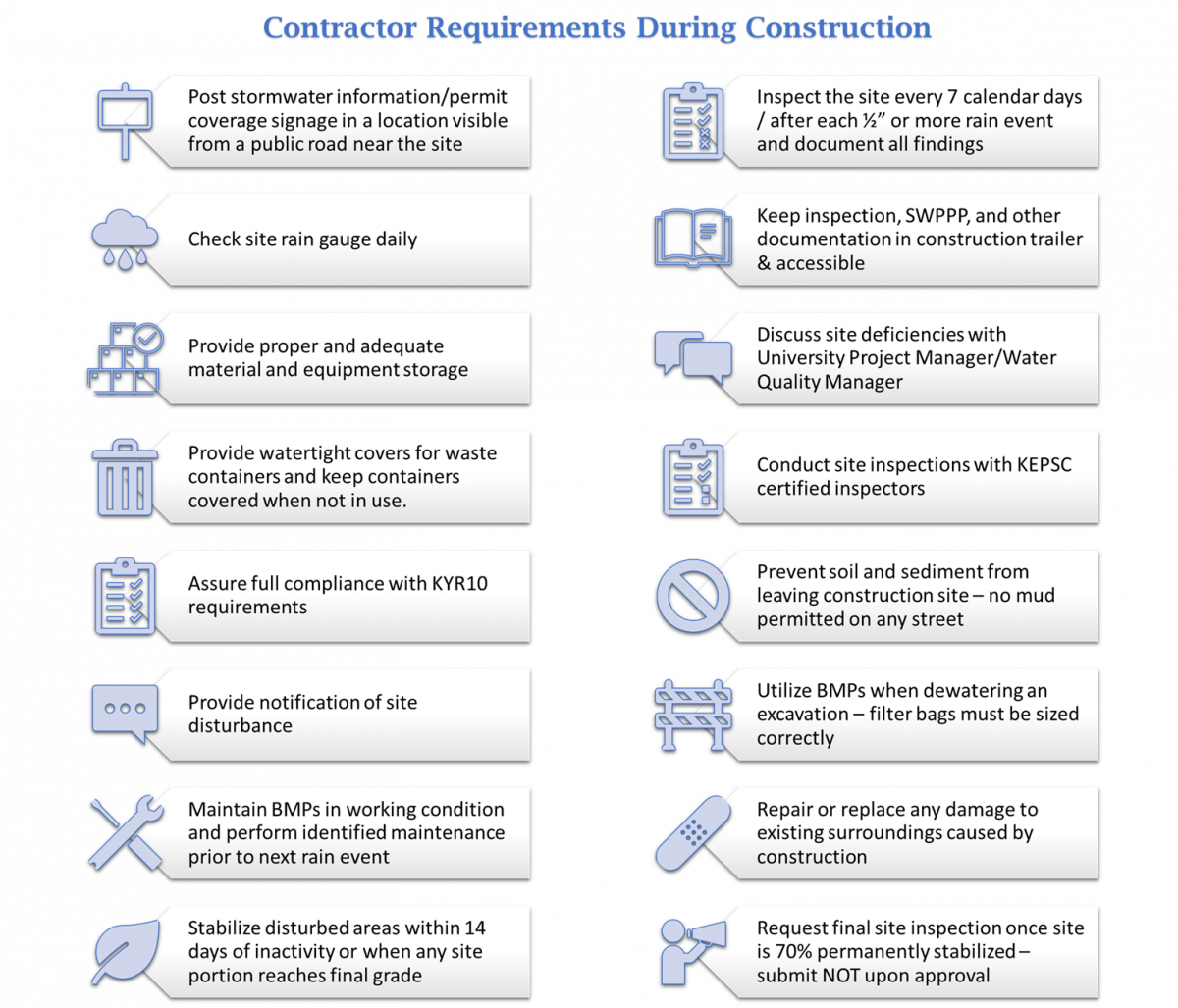
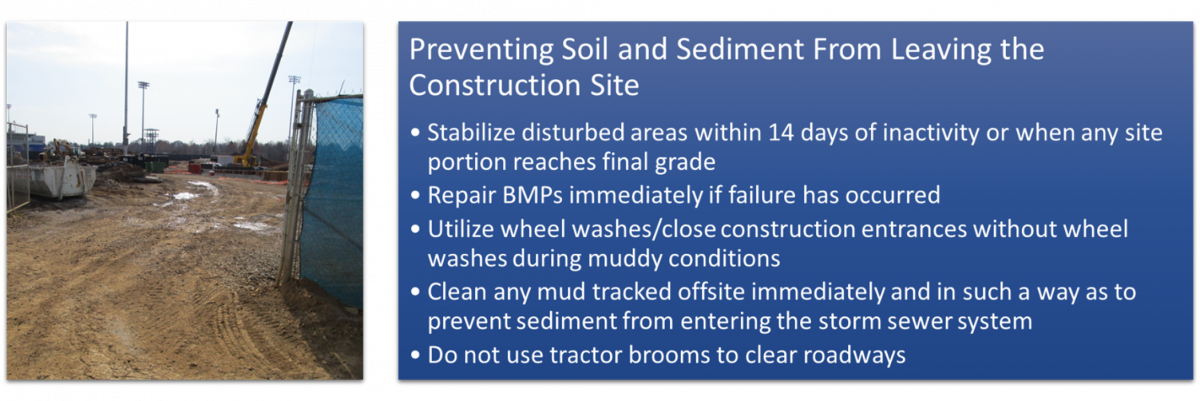
Enforcement Policy
The University routinely inspects construction sites for compliance with the EPSC, SWPPP, and General Permit. Any deficiencies noted, requested corrections or repairs, or additional BMPs requested are to be installed as soon as site conditions are favorable but no more than 7 days from the date of inspection. Failure to remedy violations and/or repeat violations will require the contractor/construction manager to contract with a third party to remediate all violations at the cost of the KYR10 permit holder. The Site Contractor shall list Erosion and Sediment Control cost separately in the schedule of values and pay applications shall be made based on the schedule contained within the Design Standards. Any fines or other costs resulting from failure to comply that are levied against the University will be assessed against the Construction Manager’s or General Constructor’s funds.
LFUCG Requirements (Designers)
As an MS4 permittee and discharger to the LFUCG storm sewer system, the University has adopted the majority of the standards set forth in the LFUCG Stormwater Manual in order to meet permit requirements and to work cooperatively with LFUCG to reduce stormwater pollution within our community. The LFUCG Stormwater Manual establishes minimum uniform standards to assure quality in the design and construction of stormwater infrastructure in development projects, standards for construction site stormwater runoff control and post-construction stormwater management, as well as requirements for stormwater management design information that must be submitted for approval. The three most often referenced sections of this manual include:
CHAPTER 1 – Stormwater Management Requirements
Addresses the Stormwater Management Criteria as well as sets the Post-Construction Water Quantity and Quality Standards for New and Redevelopment, a summary of which can be seen in the below tables from section 1.1 of the October 2020 manual:
|
TABLE 1-1 – STORMWATER MANAGEMENT CRITERIA |
|
|---|---|
|
Stormwater Management Criteria |
LFUCG Stormwater Manual Requirement |
|
Natural Resources Inventory |
Section 1.4.4 – This manual establishes a 50-foot no-disturbance vegetative buffer zone along each side of a stream and around wetlands. Section 1.5.4 – The manual generally prohibits development within the 100-year floodplain. |
|
Runoff Reduction in New Development |
Section 1.7 – The manual requires a portion of the runoff volume from impervious areas to be retained on-site using green infrastructure stormwater controls. |
|
Water Quality Volume in New Development |
Section 1.7 – The manual requires that all runoff from impervious areas must pass through a stormwater control sized for the 90th percentile storm of 1.2 inches. |
|
Channel Protection in New Development |
Section 1.7 – To minimize streambank erosion, the manual requires that detention facilities be provided for drainage areas greater than 10 acres, sized to provide 24-hour detention of the runoff volume for the 10-year 6-hour storm. |
|
Flood Control in New Development |
Section 1.6 – The manual requires that stormwater controls be provided to reduce post-development peak flows to pre-development levels. |
|
Redevelopment |
Section 1.8 – The manual requires that redevelopment projects reduce the baseline (conditions prior to demolition) impervious area by 20%, or provide stormwater controls for 20% of the baseline impervious area, or a combination thereof. In addition, if a redevelopment project results in a net increase of impervious area, the new development standards shall apply to the net increase. |
|
TABLE 1-2 –SUMMARY OF POST-CONSTRUCTION WATER QUANTITY AND WATER QUALITY STANDARDS |
||
|---|---|---|
|
New Development |
Redevelopment |
|
|
Water Quantity |
Peak flow shall be reduced to pre-development levels for the 10-year, 100-year, 1995, and 2006 storms. |
Peak flow shall be reduced to baseline (before demolition) levels for the 10-year, 100-year, 1995, and 2006 storms. No detention is required if the impervious area is not increased. |
|
Water Quality |
Water Quality Volume – All runoff from impervious areas shall pass through a stormwater control sized for the 90th percentile storm of 1.2 inches. Runoff Reduction – Green infrastructure controls shall be designed to retain on-site the runoff volume equal to 0.8 inches multiplied by the impervious area. Channel Protection – To minimize streambank erosion, detention shall be provided for drainage areas greater than 10 acres, sized to provide 24-hour detention of the runoff volume for the 10-year 6-hour storm. |
The baseline impervious area shall be reduced by 20%, or stormwater controls shall be provided for 20% of the baseline impervious area, or a combination thereof.
If a redevelopment project results in a net increase of impervious area, the new development standards shall apply to the net increase. |
CHAPTER 10 – Post-Construction BMP Design Criteria
Sets the minimum design and construction standards for post-construction stormwater controls. Detailed design information (including submittal requirements) and plans are provided for the following types of controls:
- Green Infrastructure
- Manufactured Treatment Devices
- Detention Basins
- Extended Detention Basins
- Wet Ponds
- Underground Stormwater Controls
- Constructed Wetlands
Plant lists are also provided for each of the BMPs that use vegetation as part of the treatment system.
CHAPTER 11 – Erosion and Sediment Control
Provides requirements for BMPs to be used for erosion and sediment control and good housekeeping during construction activities. Both structural and non-structural practices are discussed and are required. Details of the site requirements based on limits of disturbance (as seen in the above chart) are also included as are requirements for Erosion and Sediment Control Plans. Standard details of common practices are also provided.
A Summary of EPSC Plan Requirements and Construction BMPs as well as an Erosion and Sediment Control Plan Development Checklist is available to aid in plan development and ensure all requirements are being met.
Kentucky Division of Water KPDES Stormwater Requirements (Contractors)
Erosion and Sediment Control on construction sites of one acre or greater (or of smaller sites that are part of a larger common plan) is controlled by the Kentucky KPDES General Permit for Stormwater Discharges Associated with Construction Activities (KYR10). SWPPP requirements (along with other conditions) are outlined in the permit and cover construction as well as construction-related activities such as construction materials or equipment storage or maintenance.
To request coverage under the permit, a Notice of Intent (NOI) must be submitted to the Kentucky Division of Water. Construction shall not begin until the KYR10 has been issued and a copy of the permit provided to CPMD and EQMD. Upon completion of construction and University approval, a Notice of Termination (NOT) must be submitted to the Division of Water with a statement certifying that all stormwater discharges associated with the construction activity have been eliminated.
Key Requirements of the Permit:
SWPPP Development & Maintenance
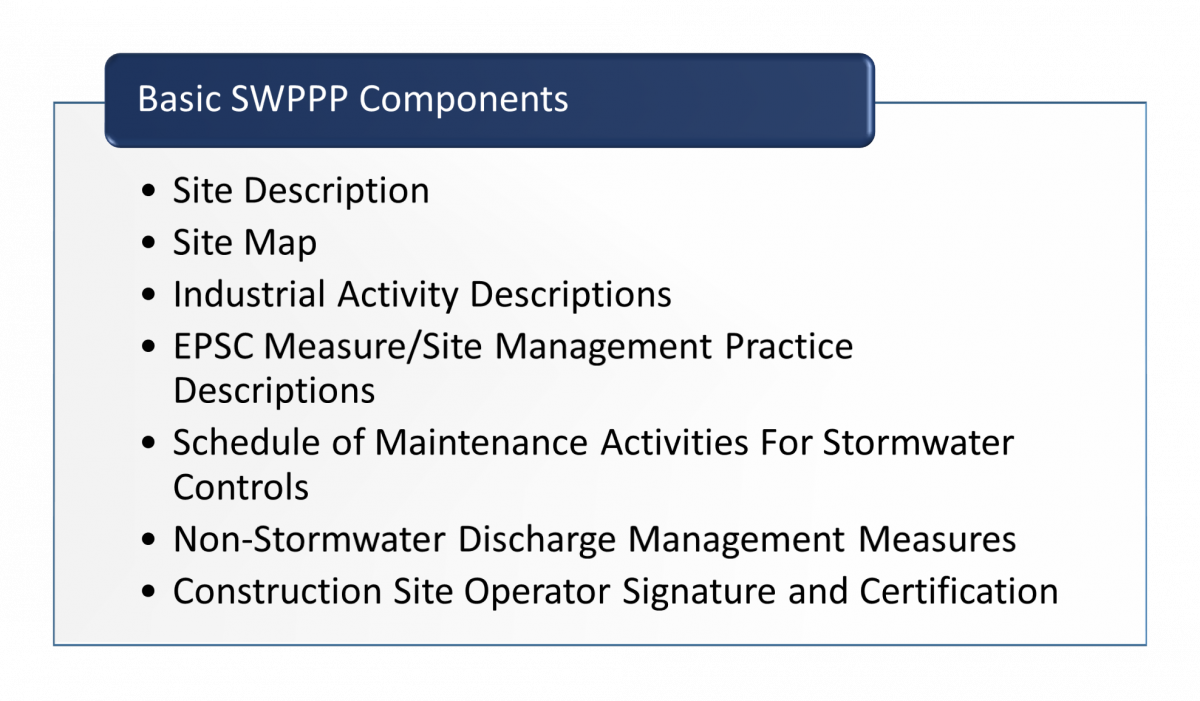 The development and implementation of the SWPPP at the commencement of construction disturbance.
The development and implementation of the SWPPP at the commencement of construction disturbance.
- Maintaining an updated plan – revision of the SWPPP whenever measures are significantly modified (within 7 days of modification)
Signage
- Signage/notice of permit coverage is to be posted in a safe, publicly accessible location in close proximity to the construction site that is visible from the public road nearest the construction site.
- The sign must include:
- The KPDES Permit Number
- Contact name and phone number for obtaining additional construction site information
- Information apprising the public on how to contact the state if stormwater pollution is observed in the discharge
Inspections
- Regular inspections by qualified personnel must be conducted as follows:
- At least once every seven calendar days, or
- At least once every fourteen calendar days and within 24 hours after any storm event of 0.5 inch or greater
- A current copy of the SWPPP and all inspection records must be readily available for review
Waste Management
- All waste container lids must remain closed when not in use and at the end of the business day for containers that are actively used throughout the day. For waste containers without lids, a cover, temporary roof, or secondary containment, etc. must be used.
Minimization of Disturbance
- A plan should be in place to minimize disturbance and the period of time that the disturbed area is exposed without stabilization practices.
– BMPs shall be implemented on critical disturbed areas within 24 hours after completion of grading. - Stabilization of disturbed areas should take place within 14 days of inactivity or upon reaching final grade on any portion of the site.
Available Training
Current Campus Projects
Detailed information regarding current campus construction projects can be found on our Campus Construction webpage. Here you will find descriptions of each project, individual site maps, project schedules, and links to construction cameras. The below map provides the location of all current campus construction projects.


